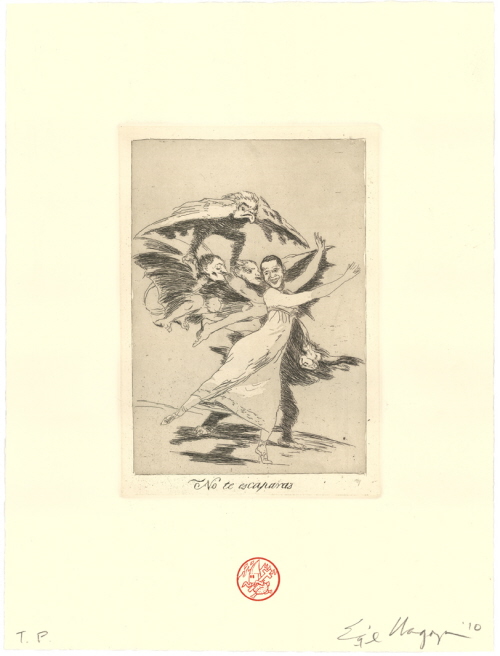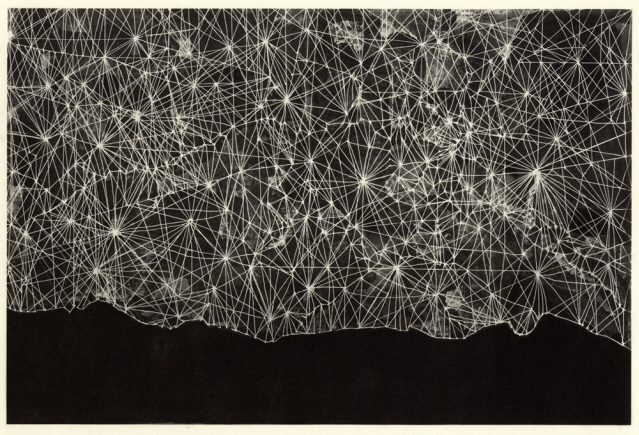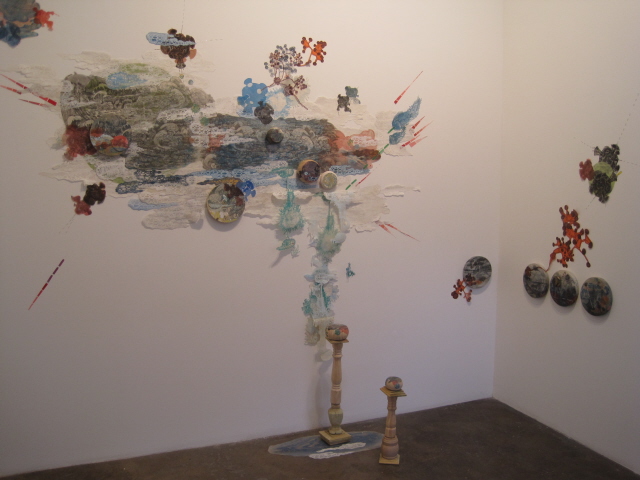
Enrique Chagoya, “Return to Goya No. 9,” 2010. Intaglio with letterpress in two colors on Revere Ivory. Plate: 8 ½ x 6 in.; Sheet: 14 5/8 x 11 in. Published by Universal Limited Art Editions, Bay Shore, NY, as a Benefit for IPCNY. © Enrique Chagoya/Universal Limited Art Editions, 2010.
In 1995, a group of print-world professionals and collectors based in New York joined forces to establish a non-profit organization that would be “dedicated to the appreciation and understanding of the fine art print.” In its early years, the International Print Center New York (IPCNY) did not yet have a gallery presence or public location, but maintained a website and organized member events and fundraising auctions. The fall of 2000 marked the auspicious beginning of IPCNY’s public exhibitions and permanent gallery, with two simultaneous shows in New York. The first, titled New Prints 2000, opened September 20 of that year and inaugurated IPCNY’s gallery on West 26th Street. The second was a satellite exhibition at AXA’s midtown galleries titled Hard Pressed: 600 Years of Prints and Process, which opened November 2. The exhibition was accompanied by a catalogue written by guest curators Elizabeth Wyckoff and David Platzker and was a dazzling survey of some of the greatest achievements in the medium throughout history. In a recent conversation, founding and current Director Anne Coffin explained that Hard Pressed was intended to demonstrate the “range and ambition” of IPCNY’s interests. Grace Glueck of The New York Times declared it “nothing short of a banquet for the eye.”
In the ten years since, IPCNY has organized over 50 exhibitions, primarily highlighting new editions. Many are offered as part of its touring program, which caters to other non-profit institutions. Coffin explained that IPCNY’s exhibition program was conceived to “fill a niche” between traditional museum and gallery exhibitions and “provide an alternative for emerging artists across the country whose work would not be seen otherwise.” In addition to its quarterly New Prints exhibitions (juried shows that showcase editions completed in the previous 12 months), IPCNY has also organized numerous special exhibitions. In tune with the New Prints program, these exhibitions often explore topics that may not receive attention elsewhere, such as the recent Seeing God in Prints: Indian Lithographs from the Collection of Mark Baron and Elise Boisanté, which traveled to Wellesley College last year; and Wallworks: Contemporary Pictorial Wallpapers, which will be on view March 9 – April 1 at the Museum of Fine Arts at Georgia College and State University, Milledgeville, Georgia.

Victoria Burge, "Montana Night," 2010. Photopolymer intaglio, edition of 10, 17 ½ x 21 inches. Printed and published by the artist (in New Prints 2010/Autumn, organized by IPCNY and currently on view at the University of Texas at Austin). Image courtesy IPCNY, New York.
This season, IPCNY is celebrating its tenth year on 26th street with a new space a few doors down (508 W. 26th #5A) and a roster of special exhibitions and benefit programs. This year’s opening exhibition, Emerging Images: The Creative Process in Prints (curated by Wendy Weitman), was a tightly-curated group of progressive proofs and multiple states of works by 16 artists ranging from Arthur Wesley Dow to E.V. Day, highlighting the unique creative possibilities provided by the medium due its serial nature. The following exhibition, New Prints 2010/Autumn – 43 works by emerging and established artists – was shown at IPCNY in October and November and is now on view through March 12 at the Visual Arts Center in the Department of Art and Art History at the University of Texas at Austin, in conjunction with its Printmaking Convergence program.
As with previous exhibitions of its kind, New Prints 2011/Winter, on view through March 5 in IPCNY’s gallery, provides a glimpse into the wide range of approaches and styles in contemporary graphic art worldwide, from traditional formats to installation-based work and socio-political commentary to strictly aesthetic explorations. A majority of the work is by emerging artists, published in extremely limited editions by small presses or the artist. Some are unique works that incorporate printmaking media. Larger editions by established publishers Carolina Nitsch and Dieu Donné Papermill are also represented in work by Vera Lutter and Glen Baldridge, respectively.
New Prints 2011/Winter includes a handful of technique-based prints. New Yorker Carla Aspenberg’s Untitled – an impression printed from a shattered pane of glass – represents a more experimental approach to the medium, while the intricate landscapes of Washingtonian Nicholas Brown (Underbrush 24) and Vancouver-based Elisabeth Sommerville (Abyss) are stunning technical achievements.
A number of prints in the exhibition use surrealistic imagery to explore psychological or socio-political themes. Color screenprint Let’s Play Mother by Belgian artist Els Ceulemans explores the psychological ramifications of motherhood with startling metaphorical bodily imagery reminiscent of Louise Bourgeois. The negative ramifications of consumer culture are explored in works such as Tourniquet by Boston-based artist Edward Monovich; Oh by Californian Kit Boyce; and British (Petroleum) Invasion by Louisianan Blake Sanders, among others.

Tai Hwa Goh, “LULL-1, LULL-4, LULL-5,” 2010. Installation detail: intaglio on hand-waxed paper, collage, mounted on wood board and affixed to gallery walls. Unique work, variable dimensions. Printed and published by the artist. Image courtesy IPCNY, New York.
Multiples, artists’ books, and installation-based work are also well represented. The dioramic artist’s book When We All Ride Together by Oregonian Stephen Funk is a multi-media celebration of Blues musician Jesse Mae Hemphill’s song of the same title. Brooklyn-based Sarah Nicole Phillips provides a handy screenprinted label that can be affixed to discarded property to inform passers-by of the object’s condition in her Curbside Object StatusTag. One of the most visually dazzling works in the show is LULL-1, LULL-4, LULL-5, a labyrinthine wall-mounted installation by New Jersey-based Tai Hwa Goh that conjures a primordial/biological landscape.
IPCNY’s next exhibition, Artists Collect: Prints from the Collections of Sol LeWitt, Kiki Smith, Philip Taaffe, and Richard Tuttle, opens with a March 10 reception from 6-8 and will be on view through May 28. Curated by New York-based independent curator and critic Harper Montgomery, the exhibition provides rare insight into these famed artist’s interests, with illuminating and sometimes surprising results. Examples from Sol LeWitt’s estate include Robert Ryman’s cover for the 1975 paintings issue of the cult-classic art ‘zine Art-Rite; John Baldessari’s artist’s book Throwing Three Balls in the Air to Get a Straight Line (Best of Thirty-Six Attempts), 1973; a 1986 photostat by Barbara Kruger; a 1971 lithograph by Cy Twombly; and handful of Ukiyo-e prints by Hirosada, Hokusai, and Yoshiiku. Kiki Smith’s collection is represented by works such as Lee Bontecou’s Eighth Stone, 1968; John Cage’s portfolio of four drypoints titled Where R = Ryoanji, 1983; and a 1945 lithograph by Pablo Picasso. Philip Taaffe’s collection of natural history books from the Sixteenth through Eighteenth Centuries includes such scientific rarities as Pietro Andrea Matthioli’s De Discorsi di M. Pietro Andrea Matthioli Sanese, Medico Cesareo… (Venice: Apresso Felice Vagrisio, 1585) and Jan Jonston’s Historiæ naturalis de quadrupedibus libri III (Amsterdam: Joannem Jacobi fil. Schipper, 1657). Also on view from Taaffe’s collection will be selected anonymous Syrian relief prints. Selections from Richard Tuttle’s print collection include a 1944 Josef Albers woodcut titled Tlaloc and significant group of German Romantic and Symbolist prints, including Carl Wilhelm Kolbe’s Die Kuh im Schilfe (Cow in the Rushes), 1799/1800, and Max Klinger’s Herodes (Herod), from Vom Tode, Erster Teil (On Death, Part I), 1889.

Carl Wilhelm Kolbe, “Die Kuh im Schilfe (Cow in the Rushes),” 1799/1800. Etching, plate: 11 7/8 x 16 1/8 in. Image via Wikimedia Commons.
New Prints 2011/Spring, on view beginning in early June, will be selected by Trenton Doyle Hancock. The tradition of an artist-curated exhibition each spring began in 2005 with selections by Kiki Smith (the idea was suggested by curator Barry Walker who chose works for spring 2004). Other artists who have been invited to jury the IPCNY spring exhibition are Richard Tuttle, James Siena, Jane Hammond, Polly Apfelbaum, and Philip Pearlstein.
IPCNY’s Tenth Anniversary season also includes three benefit initiatives, including a benefit print by Enrique Chagoya titled Return to Goya No. 9 (illustrated top). Published by Universal Limited Art Editions and donated by ULAE and the artist, it is currently on view at IPCNY and the Mary and Leigh Block Museum of Art, Northwestern University, Evanston, Illinois through March 13 in the exhibition The Satirical Edge in Contemporary Prints and Graphics.
Return to Goya No. 9 builds on the artist’s earlier suite of eight etchings titled The Return to Goya’s Caprichos (Segura Publishing Company, 1999) in which he appropriated imagery from selected plates of the master artist’s iconic suite of 80 intaglio prints, originally published in 1799. Likewise, Chagoya borrowed Goya’s original intention of allegorical political commentary, replacing the heads of the original characters from Los Caprichos with those of contemporary political figures (the suite of eight was on view with counterparts by Goya at the Metropolitan Museum of Art last summer and fall). In the artist’s recent addition to the theme, the original maiden from plate 72 – No te escaparás (You will not escape) – is now Barack Obama.
In addition to this year’s special programming, IPCNY has continued to provide information on opportunities for artists, museum and gallery print exhibitions and events in the New York area, printmaking programs at institutions of higher education, publisher activity and archives, and basic education on the medium printmaking as an art form, all of which is available on its website. As demonstrated by this season’s programs, IPCNY’s activities illuminate and consolidate the diverse and abundant world of prints for its members and followers. Ten years of this important work is certainly cause for celebration.



